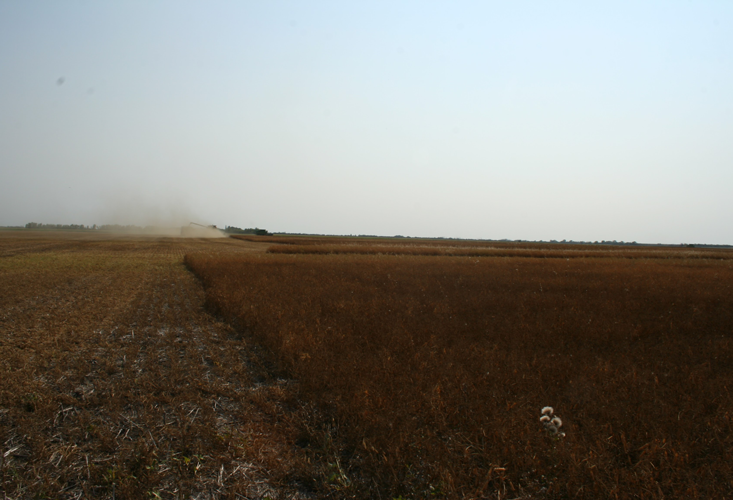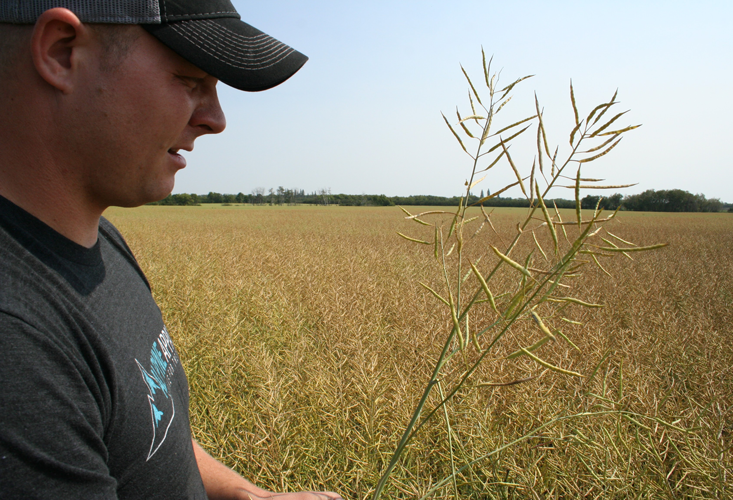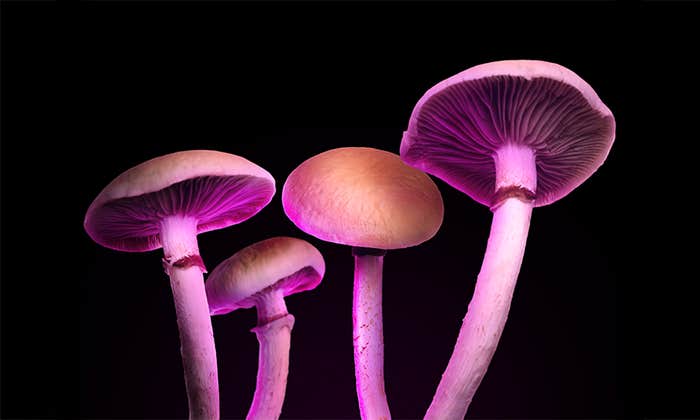Driving down a grid road in central Saskatchewan, a machine that looks like a giant insect approaches me in a cloud of dust. The cab, hanging 8 feet above the road, is suspended by tires at least 6 feet tall, with wing-like appendages folded along each side. Should I drive around it or under it?
It is harvest season, and the high-clearance sprayer is on its way to desiccate a field. Desiccation may be the most widespread farming practice you’ve never heard of. Farmers desiccate by applying herbicide to their crops; this kills all the plants at the same time, making them uniformly dry and easier to cut. In essence, desiccation speeds up plant aging. Before desiccation, crops would have to dry out naturally at the end of the season. Today, there are examples of desiccation being applied to every type of conventional crop in Canada, the United States, and the United Kingdom.1 Chances are that most of what you ate today was harvested using a desiccant, but you’d never know.

Mike Shewchuk jumps down from his swather as I pull into his farmyard. He is a young farmer whose blond brush cut and a robust stride would have not been out of place 50 years ago. Along with his dad, uncles, and brother, he farms 15,000 acres an hour outside of Saskatoon, Saskatchewan. They recently received a century farm award, for having continuously farmed the land since the early 1900s.
He is in the middle of a cut, and asks if I would mind riding with him as we talk. I climb up beside him on a small fold-down seat.
Swathers are giant lawn mowers farmers use to cut crops. The cut plants are left to dry on the ground before combining. It can be tricky knowing when to cut. If you start too early, you’ll get too many green seeds. Depending on the crop, that might lead to early germination (wheat) or self-combustion (canola). But if you wait too long, you may be scraping your seeds off the ground after the snow melts.
I doubt that I’ll be able to tell which fields had been desiccated. But the shriveled, brown peas are in stark relief to the green fields around it.
Swathing is quickly going out of fashion, as most farmers desiccate to ripen their crops. One of the big agro-chemical companies even has a marketing campaign with the hashtag #sellyourswather, encouraging farmers to desiccate and ditch swathing altogether. I asked Mike why he hadn’t sold his swather yet.
He laughs. “We’re not desiccating canola, and canola is paying the bills right now.”
For many farmers, that is changing. Until recently, farmers did not desiccate canola because it “shattered” the seedpods, shedding the seeds in soil. But breeders have been busy: In 2017, five new varieties of shatter-resistant canola were released in Canada. That will make desiccation viable for Canada’s second-most common crop, and accelerate a trend that began around 10 years ago, when desiccation started to become popular.
Not coincidentally, it was also around then that herbicide use spiked. When you sit down to eat dinner today, there will probably be desiccant in your food.
There are thousands of ways to kill a weed. You can starve it, bleach it, mess with its proteins. You can feed it fake hormones. You can force it to make acid so that it disintegrates from within. There are more than 400 licensed weed killers, or herbicides, in Ontario alone. And we love to use them. Canadians used more than 58,000 tons in 2014, compared with only 21,000 tons in 1994. Our landscape, and our crops, have never been so saturated.
Our thirst for herbicides is partly due to GMOs like RoundupReady corn, soy, and canola. These herbicide-tolerant crops came on the market in the late 1990s, and changed the farming landscape by making it possible to control weeds by using herbicides on crops still in the field.
Herbicide resistance explains part of the increase in herbicide use around the world over the past decades. If you blast a weed with herbicide, eventually its cells become resistant. Farmers are left with fields of weeds they can’t kill. This is what happens in people, with antibiotic resistant bugs. Faced with resistant weeds, farmers double down, spraying even more and using multiple herbicides. But desiccation accounts for a significant part of the growth in herbicide use. It’s impossible to say precisely how much, because stats are tracked for herbicide use by crop—not by usage type.
In theory, anything that kills a plant can desiccate a crop, but farmers can only use herbicides that are licensed as desiccants. In practice, there are only a few that are regularly used.
Glyphosate is increasingly used as, or with, desiccants. It’s sold under the trade name RoundUp, and is the most commonly used herbicide in the world, as well as the most commonly used desiccant. In 1974, global use of glyphosate was 3,200 tons per year. It is expected to reach 1 million tons per year by 2020.1 In the U.S., the rate of growth has been accelerating. Between 1995 and 2004, glyphosate use grew by 356 percent. Between 2005 and 2014, it grew by 637 percent.2
Glyphosate works by interrupting protein synthesis in plants, rendering them unable to photosynthesize. It is also considered relatively safe for humans. But in 2015 the World Health Organization (WHO) declared it a possible carcinogen, on the basis of an independent survey of the scientific literature. Outrage from governments and industry around the world fueled a reanalysis by the Food and Agriculture Organization of the United Nations and WHO, which concluded in 2016 that it was “unlikely to pose a carcinogenic risk to humans through diet.”
Industry, and farmers, breathed a sigh of relief. The reports analyzed, however, did not consider the increase in exposure to glyphosate via desiccation. This practice has dramatically increased the dissemination of glyphosate into the environment, and into us.
There have been no explicit tests of the effect of desiccation on our microbiome.
I asked Sheri Roberts, a crop specialist with Agriculture and Agrifood Canada in Moose Jaw, Saskatchewan, whether she thought desiccation was safe. She was reluctant to make the call, but said she wished it was not so commonly used. “The timing’s really tight,” she said. “If you don’t get it just right, that herbicide ends up in the grain.” If farmers apply a non-contact herbicide (like glyphosate) too early, it will be taken up by the growing plant and end up inside the seed. Non-contact herbicides are taken up by the living plant and incorporated into still growing tissues, while contact herbicides kill the tissues they touch.
A 2015 study by the Canadian Food Inspection Agency found glyphosate in 30 percent of 3,200 food products.3 Similar studies have found glyphosate exceeding maximum residue limits (or MRLs) in Cheerios, beer, and wine.4,5 MRLs are the allowable concentration of herbicides on food crops. Health Canada and the Environmental Protection Agency (EPA) come up with MRLs by feeding rats or dogs herbicide until an effect is observed. The figures are important for trade: If countries have different MRLs, shipments can be rejected. In 2011, the European Union rejected a shipment of Canadian lentils because MRLs were 40 times the EU limit. Alternatively, countries can use MRLs to negotiate a lower price, or raise their MRLs in response to industry pressure.
According to the EPA, between 1993 and 2015, glyphosate MRLs increased by 100 percent to 1,000 percent in the U.S., depending on the crop. Desiccation has changed the game: Because we are using more herbicides, herbicide residues and MRLs have also gone up. Countries can use MRLs as a bartering tool to negotiate lower prices, and will raise their MRLs in response to pressure. Monsanto and other manufacturers of glyphosate have requested increases in MRLs, and been granted many of them.2
Current MRLs for glyphosate range from 0.2 ppm to more than 300 ppm, depending on the crop. Between 1993 and 2015, the U.S. EPA glyphosate tolerance levels have increased by a factor of 50 for corn, and 2,000 for alfalfa.2
As MRLs rise, some industry groups are starting to avoid desiccated crops. Stuart Smyth, an agricultural economist at the University of Saskatchewan, tells me that certain oat millers are no longer accepting desiccated oats. “They say it’s because they don’t mill as well,” he says, “but there’s not a single study showing this.”
The millers might be worried about more than oat milling properties. General Mills, producer of Nature Valley granola bars, was recently sued by a group disputing their claim to be 100 percent natural. Because oats are commonly desiccated before harvest, the grains contain glyphosate residues. The case was dismissed in July this year, because the judge ruled that the glyphosate residues satisfied EPA standards.
At first, I doubt that I’ll be able to tell which of Shewchuk’s fields had been desiccated. But the shriveled, brown peas are in stark relief to the green fields around it. Even if the surrounding crops hadn’t been green, the sprayer tracks, squashing a path through the dead plants, are a dead giveaway.
As we drive along, the pale green, almost rubbery stems of canola are left denuded on the bare soil, while brown seedpods collect in neat windrows behind us.

After the canola, we stop by a field of wheat. It is mostly yellow, but there is still a tinge of green in places, and the occasional deep, green weed, which is the real clue that it hasn’t been desiccated. We enter the field, pushing aside the prickly, barbed awns. He slides some grains off a head and hulls them in his palm.
“We’ll probably spray it this week, could have sprayed earlier, ” Shewchuk decides, chewing on some berries.
Why spray—why spend the extra fuel and herbicide, if the crop is ready to go?
“Insurance. When we spray we can harvest within 10 days.”
Given that he has roughly one month to get the crops off the field before the frost, I’m starting to see that it might be impossible to do any other way. The farm is so big that its fields are never ready to cut at the same time. It’s not the big machines that allow Shewchuk to farm such a massive operation—it’s the herbicide.
“Farms these days are huge,” Chris Willenborg tells me. “A large farm is 30,000 acres.” Willenborg is a farmer as well as an academic, at the University of Saskatchewan. “In my ‘farmer’ hat, desiccation makes sense because it’s efficient,” he says. I can’t visualize the scope of a farm that big. It could have different soil types, different climates even. It could be hard, even impossible, to have good weather long enough to harvest it all.2
There are economic reasons, too, for desiccation. There hasn’t been a new herbicide in 25 years because they’re so expensive to develop. If herbicide sales have topped out, why not encourage pre-harvest spraying, and sell twice the product? In business circles, this is called increasing “use patterns.” Willenborg tells me that farmers are being pushed to desiccate by herbicide manufacturers. Reporters for industry standards like The Western Producer, a bible for Canadian farmers, frequently run editorials about proper desiccation protocols.
The question is: How much is too much?
“In my ‘researcher hat’, I’d say we already apply too much herbicide,” Willenborg says. “Some weeds are good—you don’t want to get rid of all weeds. What would the seed predators eat?” Willenborg sees the cropping system as an ecosystem whose health relies on things like weeds and insects.
Then there is the question of gut health.
Desiccants kill more than plants. Herbicides like glyphosate also kill bacteria. You could just as easily call them “antibiotics.” Our gut bacteria are sensitive to antibiotics, which is why we should avoid eating herbicides. When our microbes are healthy, our immune system is stable. But when microbes are disturbed, diseases like obesity, Alzheimer’s, or celiac disease can result.
Long-term exposure to antibiotics results in lasting shifts in gut microbiota. Cattle are fed low dose antibiotics in feedlots—not to stave off disease, but because it makes them gain weight more easily than an antibiotic-free cow. It changes their gut microbes so that they grow fat on less food. A study from March this year showed that glyphosate exposure changed the composition of honeybee gut microbes, which could make the bees more susceptible to colony collapse.6
Herbicides are particularly dangerous for gut microbes because they’re poorly absorbed by the gut. Low absorption means that gut bacteria are subjected to prolonged contact with the herbicide as it passes through the digestive system. Ironically, poor absorption is part of the reason that herbicides are deemed safe enough to put on our food.
We can’t prove that that there is any health cost to the practice. But neither can we say there isn’t a cost.
“We don’t actually know what happens when gut microbes are exposed to herbicides,” Deanna Gibson tells me. She studies the interaction between diet, gut microbes, and disease at the University of British Columbia, Okanagan. Her lab is a hive of researchers from around the world homogenizing frozen poop samples and mice guts. “It’s shocking to me that the chemicals we feed to lab mice to disrupt gut function are actually common herbicides—like glyphosate,” Gibson says. “How are we not talking about this as a society?”
Part of the answer is that neither Health Canada nor the U.S. EPA consider herbicides as antibiotics. This means that their safety assessments do not consider effects on human gut microbes. There have been no explicit tests of the effect of desiccation on our microbiome. The only studies that exist consider rats, cattle, bees, and turtles—because it is unethical to test the effects of toxins on humans.
Plus, there is other stuff in herbicides that is dangerous for both animals and microbes. Commercial herbicides are cocktails of chemicals that include herbicidal agents and chemicals that improve their delivery. These “adjuvants” include petroleum byproducts, neurotoxins, and endocrine disruptors. Adjuvants help the herbicidal penetrate the thick, waxy layer that surrounds plant cells, making them good for breaching bacterial cell walls, too. But adjuvants are not subjected to the same regulation as herbicides, and are considered “inert” without much evidence. Desiccation means adjuvants are being applied to edible crops in large quantities (as opposed to weeds, their original target). Their toxicity has not been studied.
So what can we do? To begin, we need to clearly determine how much glyphosate the human population is exposed to. My lab has started to do this—but it’s not easy. How much glyphosate are we exposed to? We can estimate residues in foods, but what about in the water table? Indirect exposure through agricultural and forestry use? Then we need to begin the difficult task of evaluating that risk, through animal models, and correlational studies in humans. This will not be easy, or fast.
Desiccation makes it possible to cultivate massive tracts of farmland and feed billions of people profitably. Based on the evidence we have so far, we can’t prove that that there is any health cost to the practice. But neither can we say there isn’t a cost—and there are many reasons to think there might be one.
On my way home from Shewchuk’s farm, I stopped by a desiccated pea field. It was a clear afternoon, but the air was heavy with dust, casting an orange glow on the field. Four combines, each as big as a small building, were kicking up dirt and chaff from the peas while two enormous semi-trailers waited to receive the seeds. At least a dozen hawks circled overhead, waiting for the rodents that were now exposed on the bare ground. I knew agriculture had changed, but I couldn’t have imagined this scene so divorced from the mom and pop farms of my childhood. The scene was from some dystopia. I was reminded of a famous quote by Alanis Obomsawin: “When the last tree is cut, the last fish is caught, and the last river is polluted … you will realize, too late, that wealth is not in bank accounts and that you can’t eat money.”
But what if we can’t eat our own food, either?
Miranda Hart is a microbial ecologist and professor at the University of British Columbia, Okanagan
References
1. Landrigan, P.J. & Belpoggi, F. The need for independent research on the health effects of glyphosate-based herbicides. Environmental Health 17, 51 (2018).
2. Benbrook, C.M. Trends in glyphosate herbicide use in the United States and globally. Environmental Sciences Europe 28, 3 (2016).
3. Canadian Food Inspection Agency. Safeguarding with Science: Glyphosate Testing in 2015-2016.
4. CBC News Staff. Nearly a third of food samples in CFIA testing contain glyphosate residues. www.cbc.ca (2017).
5. Copley, C. German beer purity in question after environment group finds weed-killer traces. Reuters (2016).
6. Motta, E.V.S., Raymann, K., & Moran, N.A. Glyphosate perturbs the gut microbiota of honey bees. Proceedings of the National Academy of Sciences 115, 10305-10310 (2018).


























